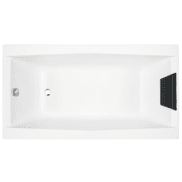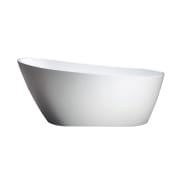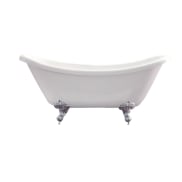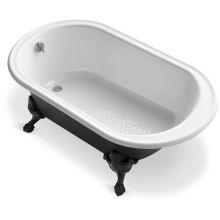5 Ways to Clean an Old Porcelain Tub
Porcelain tubs require careful attention to maintain their shine.
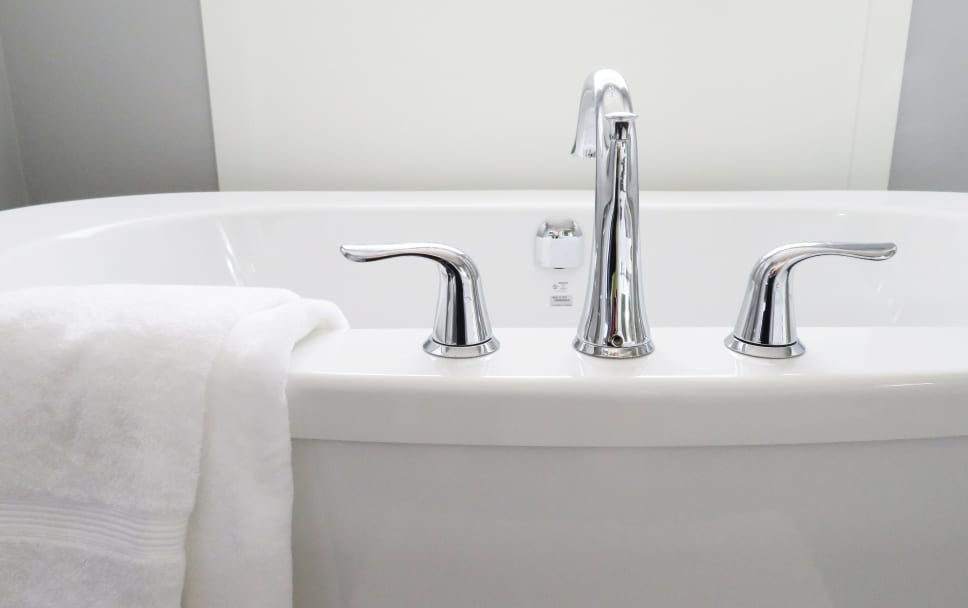
The elegant look of porcelain enamel can improve the design and function of a bath or shower, with a clean shine on the non-porous, bacteria resistant, sanitary finish. A well-cared for porcelain lined tub will look clean and new for years. However, not all cleaning materials can be used on enamel. There are a few universal tips on how to clean a porcelain bathtub that you need to know before you start.
Before You Clean
Obviously, you need to clean your tub, but there are a few cleaning methods you want to avoid. Porcelain enamel is applied like glass and fused to a cast-iron structure, a process that leaves it susceptible to dings or scratches. It might be useful to think of cleaning a porcelain enamel tub in much the same way as you would clean a mirror or a window. It can be scratched and damaged, so the chemicals used should be non-abrasive and chosen with care.
While the surface may be non-porous and smooth, it is still quite absorbent. Harsh cleaning chemicals can eat away the enamel and rough cloths or scrapers can scratch the finish underneath. Exposure to acidic cleaners over a long period of time can start to wear at the finish. The effects of damage done by chemicals won’t be seen or noticed until months later.
Be careful not to use anything with dyes in or around the tub as they can leave traces of their color behind. Always have running water going when contact with colorants, such as hair dye, is unavoidable. It’s best not to let rust or hard water stand too long on the surface as this can catch other grime and pile up to leave a mark or etch the finish. Some tubs may even get stained by water.
Another potential issue with porcelain is that the finish can start to get dull. This is especially true for older tubs and showers because the enamel might not be as acid and alkaline resistant as newer tubs. This reduced resistance means your old bathtub could be more susceptible to staining. You can reduce the chances of your porcelain enameled bathroom fixture staining by drying the bottom and sides with a clean, soft rag after each use and cleaning.
As you get ready to clean this bathroom centerpiece, you need to be sure to avoid chipping the porcelain. Certain cleaners and brushes may be harmful to the material, such as:
- Scouring powder
- Abrasive cleaners, like ammonia or chlorine bleach
- Steel wool
These cleaning tools could damage the finish and actually make your tub look worse than when you started. Chlorine bleach-based cleaner is best avoided because it can oxidize the iron in the finish on porcelain enamels and leave it looking dull. Chlorine bleach can potentially be toxic if the surface has previously been cleaned with ammonia-based cleaners, so it is best to avoid the use of these cleaners if you don’t know the history of the tub. Mixing cleaning products can be dangerous, so always be certain of the kinds of cleaners you’re using in your bathroom.
Regular Cleaning
If you clean your tub or shower on a regular basis, you won’t have to work as hard to get stuck-on soap scum off the surface. In fact, you should try to make a habit of cleaning your tub weekly. A light clean is fairly simple.
First, you need to find a cleaner that is safe for your tub. You can either make your own or buy some from the store.
- If you choose to make your own, mix a few tablespoons of dish soap with a gallon of hot water.
- For store-bought cleaners, look for cleaners that are marked as safe for porcelain enamel.
Next, wipe down the tub using your cleaner of choice with a rag or soft sponge. Do not use an abrasive, scouring sponge. Be sure to thoroughly rinse the cleaner off with fresh water. Once cleaned and rinsed, wipe the surfaces down with a soft, dry cloth to remove any standing water.
Targeted Cleaning
When there are stubborn stains that don’t disappear with regular cleaning, you can also use a cleaner made from white vinegar or lemon juice. The acid in these two natural cleaners is less abrasive than other chemical cleaners and can be just as effective. They can be applied directly to the surface or they can be diluted with water before washing over the tub. Use a clean, soft rag to scrub down the entire tub, letting it sit for a few minutes if necessary. Rinse thoroughly, making sure the acidic cleaner is washed away. Be careful not to let it sit too long on the surface.
Spot Clean
Stains may affect small areas of your tub. If a stain persists after cleaning, you may need to spot clean the surface. Minor stains may be removed using cream of tartar and a mix of water or hydrogen peroxide.
- Fill a bowl with cream of tartar.
- Slowly add the water or hydrogen peroxide to make a thick paste.
- Put the paste directly on the stains.
- Let it dry.
Once the paste has dried, rinse the mixture off using warm water and a soft cloth.
Rust Spots
If you’re trying to clean up an older, neglected tub, you may have to worry about rust spots. Even when trying to get rid of rust, you need to be sure not to use one of the potentially damaging tools, like steel wool. Surface rust may accrue on a used porcelain tub, but this blemish should come off when you do a normal cleaning of your tub. However, some stubborn rust spots may need extra effort.
When faced with more stubborn stains, what can you do to get rid of the rust? One of the harsher methods to spot clean a porcelain enamel tub is a paste, made from a combination of vinegar and baking soda. The baking soda is an abrasive, so be sure to mix it and dilute the paste well to keep from scratching the tub surface. Apply it to the stain in a circular motion, being careful not to use too much pressure that might grate on the finish or damage it. Let the paste dry, then rinse it and wipe away with a clean a rag. Once clean, dry the area.
The acidity in lemons can also be useful against rust. If cleaning with lemon juice doesn’t knock out the problem, another trick is to cut a lemon and dip a piece in a tray of salt. Next, apply the salt and lemon combination to the rust stain just as though it were a sponge. The salt mixes with the lemon juice and scrubs at the stain to remove it. However, keep in mind that the salt can scratch the finish if used too aggressively. Rinse thoroughly and wipe the area dry with a clean cloth.
Sparkling Clean
Do you want your tub to look sparkling clean every day? After you do a light cleaning, you can make the porcelain finish shine by dabbing a light coat of lemon oil onto the sides of your tub with a clean rag. Be sure not to put the oil at the bottom of your bath as it can make the surface slick and dangerous, particularly when wet. Not only does the lemon oil add shine, but it can also serve as a protective barrier for your porcelain tub to help stop soap scum and minor stains.
Porcelain enamel tubs are known for their durability and shine, but it does take a little extra work to maintain them. While some store-bought cleaners can do the trick, be very careful that they will not leave lasting damage on the finish. Most effective cleaners safe enough for a porcelain tub can be found right at home. With care and effort, the clean shine on your tub or shower will last for years.

